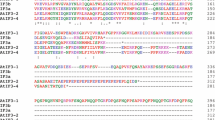Abstract
A portion of a cDNA predicted to encode the mature form of Euglena gracilis chloroplast translational initiation factor 3 (IF-3chlM, molecular mass, 46402) and the portion of this factor homologous to bacterial IF-3 (IF-3chlH, molecular mass 22829) have been cloned and expressed in Escherichia coli as histidine-tagged proteins. The homology domain can be expressed in reasonable levels in E. coli. However, IF-3chlM is quite toxic and can only be produced in small amounts. Both forms of the chloroplast factor are associated with E. coli ribosomes. Purification procedures have been developed for both IF-3chlM and IF-3chlH using Ni-NTA affinity chromatography followed by ion exchange chromatography. IF-3chlM and IF-3chlH are active in promoting ribosome dissociation and in promoting the binding of fMet-tRNA to E. coli ribosomes. However, IF-3chlH has at least 5-fold more activity than either native IF-3chl or IF-3chlM in promoting initiation complex formation on chloroplast 30S ribosomal subunits in the presence of a mRNA carrying a natural translational initiation signal. This observation suggests that regions of IF-3chl lying outside of the homology domain may down-regulate the activity of this factor.
Similar content being viewed by others
References
Bubunenko M, Subramanian A: Recognition of novel and divergent higher plant chloroplast ribosomal proteins by Escherichia coli ribosome during in vivo assembly. J Biol Chem 269: 18223–18231 (1994).
Cheng Y, Kalman L, Kaiser D: The dsg gene of Myxococcus xanthus encodes a protein similar to translation initiation factor IF3. J Bact 176: 1427–1433 (1994).
Danon A, Mayfield S: ADP-dependent phosphorylation regulates RNA-binding in vitro: implications in light-modulated translation. EMBO J 13: 2227–2235 (1994).
Danon A, Mayfield S: Light-regulated translation of chloroplast messenger RNA through red-ox potential. Science 266: 1717–1719 (1994).
Gold J, Spremulli L: Euglena gracilis chloroplast initiation factor 2: identification and initial characterization. J Biol Chem 260: 14897–14900 (1985).
Graves M, Breitenberger C, Spremulli L: Euglena gracilis chloroplast ribosomes: Improved isolation procedure and comparison of elongation factor specificity with prokaryotic and eukaryotic ribosomes. Arch Biochem Biophys 204: 444–454 (1980).
Graves M, Spremulli L: Activity of Euglena gracilis chloroplast ribosomes with prokaryotic and eukaryotic initiation factors. Arch Biochem Biophys 222: 192–199 (1983).
Gualerzi C, Pon C: Intiation of mRNA translation in prokaryotes. Biochemistry 29: 5881–5889 (1990).
Hartz D, Binkley J, Hollingsworth T, Gold L: Domains of initiator tRNA and initiation codon crucial for initiator tRNA selection by E. coli IF-3. Genes Devel 4: 1790–1800 (1990).
Hauser C, Gillham N, Boynton J: Translational regulation of chloroplast genes: proteins binding to the 5′-untranslated regions of chloroplast mRNAs in Chlamydomonas reinhardtii. J Biol Chem 271: 1486–1497 (1996).
Kalman L, Cheng Y, Kaiser D: The Myxococcus xanthus dsg gene product performs functions of translation initiation factor 3 in vivo. J Bact 176: 1434–1442 (1994).
Kishore R, Muchhal U, Schwartzbach S: The presequence of Euglena LHCPII, a cytoplasmically synthesized chloroplast protein contains a functional endoplasmic reticulum-targeting domain. Proc Natl Acad Sci USA 90: 11845–11849 (1993).
Kraus B, Spremulli L: Chloroplast Initiation Factor 3 from Euglena gracilis: identification and initial characterization. J Biol Chem 261: 4781–4784 (1986).
Kraus B, Spremulli L: Evidence for the nuclear location of the genes for chloroplast IF-2 and IF-3 in Euglena. Plant Physiol 88: 993–995 (1988).
Kunkel T, Bebenek K, McClary J: Efficient site-directed mutagenesis using uracil containing DNA. Meth Enzymol 204: 125–139 (1991).
Kuroda I, Inagaki J, Yamamoto Y: Precursor of the nuclear-encoded extrinsic 30 kDa protein in photosystem II of Euglena gracilis Z is not a polyprotein. Plant Mol Biol 21: 171–176 (1993).
Laemmli UK: Cleavage of structural proteins during the assembly of the head of bacteriophage T4. Nature 227: 680–685 (1970).
Lin Q, Ma L, Burkhart W, Spremulli L: Isolation and characterization of cDNA clones for chloroplast translational initiation factor-3 from Euglena gracilis. J Biol Chem 269: 9436–9444 (1994).
Ma L, Spremulli L: Immunological characterization of the complex forms of chloroplast translational initiation factor 2 from Euglena gracilis. J Biol Chem 267: 18356–18360 (1992).
Mayfield S, Cohen A, Danon A, Yohn C: Translation of the psbA mRNA of Chlamydomonas reinhardtii requires a structured RNA element contained within the 5′ untranslated region. J Cell Biol 127: 1537–1545 (1994).
Rochaix J-D: Post-transcriptional steps in the expression of chloroplast genes. Annu Rev Cell Biol 8: 1–28 (1992).
Sambrook J, Fritsch E, Maniatis T: Molecular Cloning: A Laboratory Manual. Cold Spring Harbor NY Cold Spring Harbor Laboratory Press, Cold Spring Harbor NY (1989).
Staub J, Maliga P: Translation of psbA mRNA is regulated by light via the 5′-untranslated region in tobacco plastids. Plant J 6: 547–553 (1994).
Subramanian A: Molecular genetics of chloroplast ribosomal proteins. Trends Biochem Sci 18: 177–181 (1993).
Wang C, Roney W, Alston R, Spremulli L: Initiation complex formation on chloroplast 30S subunits in the presence of natural mRNAs. Nucl Acids Res 17: 9735–9747 (1989).
Wang C, Spremulli L: Chloroplast translational initiation factor 3: purification and characterization of multiple forms from Euglena gracilis J Biol Chem 266: 17079–17083 (1991).
Weglohner W, Kauschmann A, Subramanian A: Evolution of the NH2-and COOH-terminal extensions of chloroplast ribosomal S18. Nucleotide sequence of pea and rye chloroplast rps 18 genes. Biochem Mol Biol Int 36: 265–273 (1995).
Wu H, Kuchka M: A nuclear suppressor overcomes defects in the synthesis of the chloroplast psbD gene product caused by mutations in two distinct nuclear genes of Chlamydomonas. Curr Genet 27: 263–269 (1995).
Zerges W, Rochaix J: The 5′ leader of a chloroplast mRNA mediates the translational requirements for two nucleus-encoded functions in Chlamydomonas reinhardtii. Mol Cell Biol 14: 5268–5277 (1994).
Author information
Authors and Affiliations
Additional information
This work was supported in part by National Institutes of Health Grant GM24963.
Rights and permissions
About this article
Cite this article
Lin, Q., Yu, NJ. & Spremulli, L.L. Expression and functional analysis of Euglena Gracilis chloroplast initiation factor 3. Plant Mol Biol 32, 937–945 (1996). https://doi.org/10.1007/BF00020490
Received:
Accepted:
Issue Date:
DOI: https://doi.org/10.1007/BF00020490




